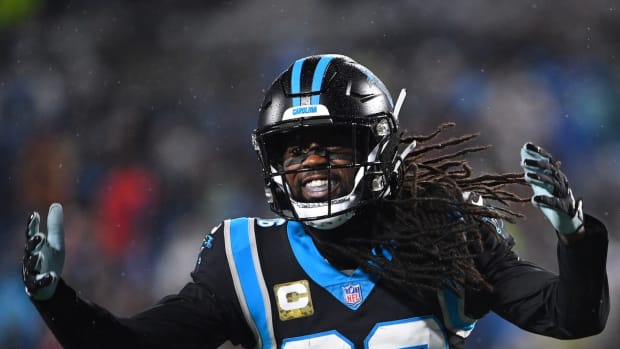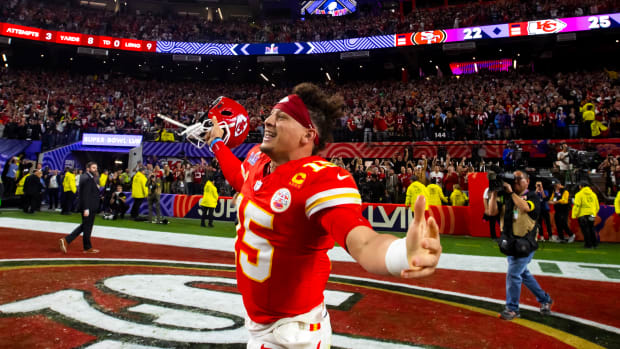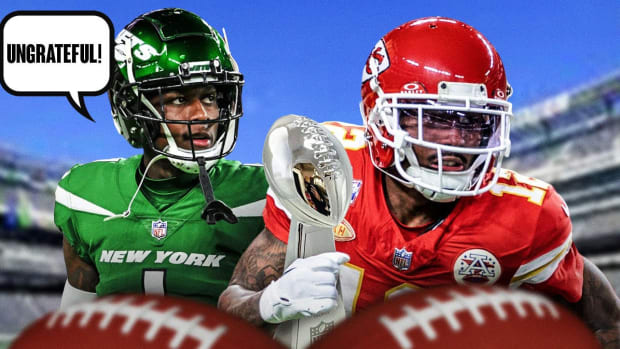Understanding Aaron Rodgers’s Unique Wavelength
ARLINGTON, Texas — “Hey, Aaron!” Martellus Bennett jumped up from his locker stall and chased after his quarterback.
Something momentous had happened earlier that day at AT&T Stadium: Bennett had, as he put it, finally gotten the scramble drill correct—figuring out where to go after the pass protection has broken down and the QB is on the run. He wasn’t going to let Aaron Rodgers leave the locker room on Sunday afternoon without gleefully reliving it.
Early in the second half, the Packers’ veteran tight end saw Rodgers facing pressure and leaking out from the right side of the pocket. Bennett, after looking back and hesitating for a second, decided to break off his original pattern and turn upfield. He knows his quarterback likes to go deep. So, as he recounted to Rodgers, “I was like, [screw] that, I’m going deep!” They connected for a 33-yard pass that helped incite Green Bay’s second-half comeback.
“Tom [Brady] doesn’t scramble like that; Eli [Manning] is not scrambling like that; [Jay] Cutler didn’t scramble like that,” Bennett said, listing three of the previous QBs he’s caught passes from in his 10-year NFL career. “It takes time to learn how to do the scramble drill with a quarterback like that.”
NFL Power Rankings Poll: Patriots Finish Regular Season On Top, As for the Browns . . .
Rodgers’s ability to throw on the run is nothing new. Nor is his aptitude for clock-beating, game-winning drives. When the Cowboys gave the ball back to the Packers—leading by only three points with 73 seconds on the clock—even the home crowd could foresee what was about to happen next: The nine-play, 75-yard drive capped by Rodgers’s perfect touchdown pass to Davante Adams in the corner of the end zone. Up in the press box, team president Mark Murphy and GM Ted Thompson leapt to their feet as Adams came down with the ball.
But the thing about a brilliant performance like the one Rodgers delivered is that it puts into context what teams on the other end of the standings are missing: A quarterback who can cure other ills around him. On that final drive, Rodgers didn’t have starting left tackle David Bakhtiari protecting his blindside (he was inactive for the game); and his No. 1 receiver, Jordy Nelson, was sidelined with an injury; and in the backfield, rookie Aaron Jones was making his first NFL start. But those end up being footnotes to the story, rather than major plot points. Case in point: after the game, right tackle Bryan Bulaga didn’t even know Nelson wasn’t playing on that final drive.
“You’ve gotta look at the past five years for this guy and the type of adversity he’s had to go through with no Jordy, the O-Line banged up, me getting hurt, [Randall] Cobb getting hurt,” Adams said. “He’s always gotta kinda just work through something. It’s never just beautiful; we never have all 11 out there healthy … he’s improvising and making it work, that’s what he does.”
College Football: What I’m Watching This Weekend
That’s become as synonymous with Rodgers’s career as anything else: Just make it work, whether it’s playing with a revolving door at the running back position or a roster banged up by injuries. The Packers offense has really only hit one rough stretch, in 2015, the year Nelson was out with an ACL tear. But for eight straight seasons, they’ve made the playoffs because of the way their quarterback elevates the play of everyone around him.
“It’s like playing with a really good point guard,” Bennett said. “Everybody is better.”
It’s difficult to make apples to apples comparisons in the NFL, but it’s hard not to notice the difference between the outlook in Green Bay compared to that of the Giants, a team that is running a near carbon-copy offense under Mike McCarthy’s former assistant, Ben McAdoo. Without a healthy Odell Beckham Jr., who has been playing through an ankle injury all season and is now out for the year after fracturing the same ankle on Sunday, the offense has not been functional.
The Morning Huddle: What Exactly Happened to J.J. Watt's Knee
Escapability isn’t essential to playing the QB position well—as Bennett said, it’s not like Brady is scrambling the way Rodgers does. But watching the Giants’ offense this year has become a bit like watching a car crash: Eli Manning all too often is standing in the pocket, willing the play not to break down while the line crumbles in front of him. The offensive system both teams use counts on its skill position players to win their one-on-one matchups—or a quarterback who makes that happen by throwing into nearly nonexistent windows or improvising when the play breaks down.
The Packers’ win on Sunday was the latest example of how well Rodgers does that. The way he explained that the first pass of the final drive to Adams set up the game-winning touchdown, because he used a different shoulder placement on each throw. The fact that he, and not McCarthy, was calling plays in the huddle on the final drive. The scramble rules that it took Bennett, a 10-year veteran, five games to master. “The way he sees the field is different,” Bennett explained. “There’s more variety, and the things he can do with his arm are very special.”
Question? Comment? Story idea? Let us know at talkback@themmqb.com




































